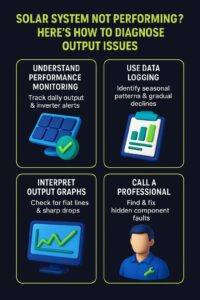A well-functioning solar system should consistently generate power that aligns with your system size, location, and weather conditions. When output starts to dip unexpectedly, it often points to issues that can be identified early with the right tools and checks. Here’s a detailed guide on how to diagnose solar performance issues by leveraging performance monitoring, data logging, and output graphs.
Understanding Performance Monitoring
Performance monitoring is the foundation of diagnosing underperforming solar systems. Modern inverters and third-party monitoring platforms track your system’s energy production in real time, giving you immediate access to vital metrics. By logging into your monitoring app or portal, you can check how much power your system is generating during peak sunlight hours compared to cloudy periods.
Key aspects to monitor include:
- Daily Energy Yield: If output is significantly lower than usual under similar weather conditions, it suggests a fault such as shading or soiling.
- Inverter Status Alerts: Many inverters will send warnings if they detect a fault or grid issue.
- Panel-Level Monitoring: Advanced systems can pinpoint exactly which panel is underperforming, saving time during troubleshooting.
Regularly reviewing your monitoring data helps you identify performance dips quickly. Neglecting monitoring can allow small issues, such as dust accumulation or bird droppings on panels, to persist and lead to larger efficiency losses over time.
Using Data Logging for Deeper Analysis
Data logging provides a historical record of your system’s performance, often stored by your inverter or through external monitoring devices. This continuous recording is essential for identifying subtle or long-term issues that may not be visible in daily monitoring.
Practical uses of data logging:
- Identifying Seasonal Patterns: It’s normal for solar output to fluctuate with seasonal sunlight changes. Data logs help distinguish between seasonal dips and actual faults.
- Spotting Gradual Declines: If energy production has been slowly decreasing, it could indicate panel degradation or shading from growing trees or new structures.
- Tracking Weather-Adjusted Output: Comparing production data with local weather records can reveal whether performance drops are due to system faults rather than cloudy conditions.
For commercial systems, data logging also provides crucial insights for energy audits and maintenance planning, ensuring that businesses can forecast energy savings and performance accurately.
Interpreting Output Graphs to Pinpoint Issues
Output graphs offer a visual representation of your solar system’s performance over time. These graphs typically display power output by the hour, day, or month and are vital for identifying abnormalities.
When reviewing output graphs:
- Look for Flat Lines: A sudden flat line in the graph during sunny hours often signals an inverter shutdown or grid disconnection.
- Note Sharp Drops: Sudden, unexplained dips during peak hours may point to intermittent shading, dirty panels, or partial string faults.
- Compare to Expected Production: Use system specifications and expected yield calculators to benchmark your output. Deviations from expected production can highlight inefficiencies early.
For larger systems, output graphs are especially useful in identifying localised problems, such as a single panel affecting the output of an entire string of panels.

Common Causes of Reduced Output
Understanding the root causes of reduced performance can help you take corrective action promptly:
- Panel Soiling: Dust, bird droppings, and debris can significantly reduce panel efficiency.
- Shading Issues: Nearby construction or vegetation growth can cast shadows on panels that weren’t shaded previously.
- Inverter Faults: A malfunctioning inverter may operate intermittently or shut down completely.
- Loose Connections: Poor wiring or damaged connectors can restrict power flow.
- Component Ageing: Older panels may produce less energy as they degrade naturally over time.
By checking for these common factors, you can resolve simple issues like cleaning panels or trimming branches before resorting to professional servicing.
Working with Professionals for Diagnosis
Some issues require more than basic checks. Experienced technicians use advanced diagnostic tools such as:
- I-V Curve Tracers: These devices analyse the electrical characteristics of each panel to detect hidden faults like microcracks or hotspots.
- Thermal Imaging Cameras: These identify overheating components or wiring problems that can’t be seen by the naked eye.
- Insulation Resistance Testers: These ensure the system’s electrical integrity and safety.
Working with a professional ensures that underlying issues are diagnosed accurately and resolved efficiently, preventing further losses or damage to your system.
Conclusion
Monitoring your solar power Perth system’s performance through real time dashboards, analysing historical data logs, and interpreting output graphs are crucial steps to maintaining maximum efficiency. Proactive action can prevent small faults from escalating into major energy losses. If your system shows consistent underperformance, consult a trusted Solar Power installations Perth specialist to evaluate your setup. Partnering with an experienced Solar power Company Perth ensures that your system continues to deliver optimal energy output, maximising your return on investment for years to come.

